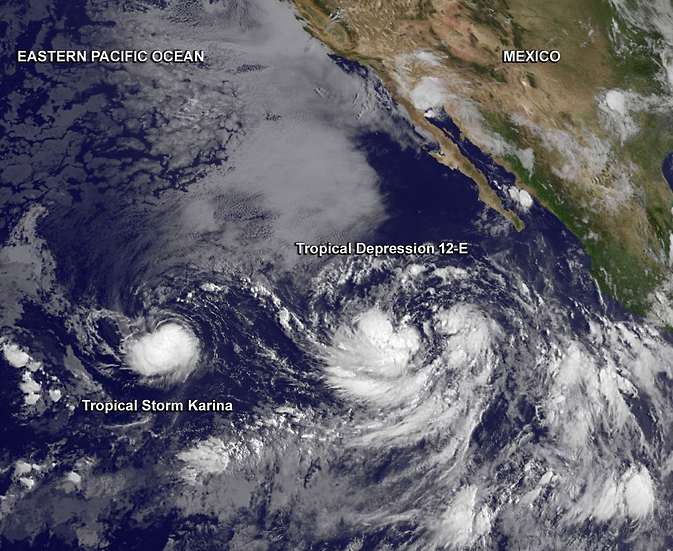Twelfth Tropical Depression Appears Huge on Satellite Imagery

On August 18, NOAA's GOES-West satellite captured an image of tiny Tropical Storm Karina followed to the east by the massive Tropical Depression12-E. Image Credit: NASA/NOAA GOES Project
Tropical cyclones are usually a couple of hundred miles in diameter. The average size of a tropical cyclone is around 304 nautical miles (350 miles/600 km) in diameter.
The National Hurricane Center noted on August 18 at 11 a.m. EDT that Tropical Depression 12-E was at least 800 nautical miles (920.6 miles/1,482 km) in diameter! By comparison, Tropical Storm Karina is a couple of hundred miles in diameter.
At 11 a.m. EDT on August 18, tropical-storm-force winds extended outward up to 80 miles (130 km) from Karina's center.
NASA/NOAA's GOES Project at the NASA Goddard Space Flight Center in Greenbelt, Maryland generates visible and infrared satellite imagery of the Eastern and Central Pacific Oceans from NOAA's GOES-West and GOES-East satellites.
On August 18, at 11 a.m. EDT (1500 UTC) the center of Tropical Depression Twelve-e was located near latitude 16.7 north and longitude 117.7 west, that's about 665 miles (1,065 km) southwest of the southern tip of Baja California.
Maximum sustained winds are near 35 mph (55 kph), and the depression is expected to become a tropical storm late on August 18.
The depression is moving toward the west-northwest near 8 mph (13 kph) and the National Hurricane Center expects a turn toward the northwest followed by a turn north on August 19.
Text credit: Rob Gutro
NASA's Goddard Space Flight Center
Media Contact
More Information:
http://www.nasa.gov/content/goddard/12e-eastern-pacific-ocean/All latest news from the category: Earth Sciences
Earth Sciences (also referred to as Geosciences), which deals with basic issues surrounding our planet, plays a vital role in the area of energy and raw materials supply.
Earth Sciences comprises subjects such as geology, geography, geological informatics, paleontology, mineralogy, petrography, crystallography, geophysics, geodesy, glaciology, cartography, photogrammetry, meteorology and seismology, early-warning systems, earthquake research and polar research.
Newest articles

Superradiant atoms could push the boundaries of how precisely time can be measured
Superradiant atoms can help us measure time more precisely than ever. In a new study, researchers from the University of Copenhagen present a new method for measuring the time interval,…

Ion thermoelectric conversion devices for near room temperature
The electrode sheet of the thermoelectric device consists of ionic hydrogel, which is sandwiched between the electrodes to form, and the Prussian blue on the electrode undergoes a redox reaction…

Zap Energy achieves 37-million-degree temperatures in a compact device
New publication reports record electron temperatures for a small-scale, sheared-flow-stabilized Z-pinch fusion device. In the nine decades since humans first produced fusion reactions, only a few fusion technologies have demonstrated…





















